ASUS ROG Rapture GT-AC5300: The gamers' router
Note: This article was first published on May 26, 2017.
ROG Expansion
Republic of Gamers or better known simply as ROG was a sub-brand formed by ASUS in 2006 to meet the needs of gamers. Today, more than a decade on, it has grown to be a formidable force and its catalog now spans the entire gamut of gaming devices and peripherals, from fully decked out gaming systems to notebooks, motherboards, graphics cards, keyboards, mice, monitors, and even sound cards.
It is an impressive line-up and a testament to how far the ROG brand has come. But in its 11 years, there was never a ROG router, which is curious because online connectivity has become a very important part of gaming. However, that all changes today with the new ROG Rapture GT-AC5300 router. This is the first ROG router and it is an absolute beast. Let me talk you through its key features.
The ASUS ROG Rapture GT-AC5300

If you are familiar with the older ASUS RT-AC5300 router, then the new ROG Rapture GT-AC5300 router should look familiar to you. The two routers are practically identical on the outside. Both routers have identical dimensions, weight, and have the same boxy look with 8 large external antennas. The only way to differentiate them is by the logo on the top panel and by its ports. The RT-AC5300 has an ASUS logo while the ROG Rapture GT-AC5300 has a ROG logo. The ROG Rapture GT-AC5300 also has way more ports, but more on this later.
The looks of the ROG Rapture GT-AC5300 is certainly controversial. Many people have described it as a spider and crab, and a good number of people also think its ugly. Personally, I’m quite fond of it. High-end routers should look different and edgy, and this design ticks those boxes for me. However, I will concede that it is really bulky and heavy.
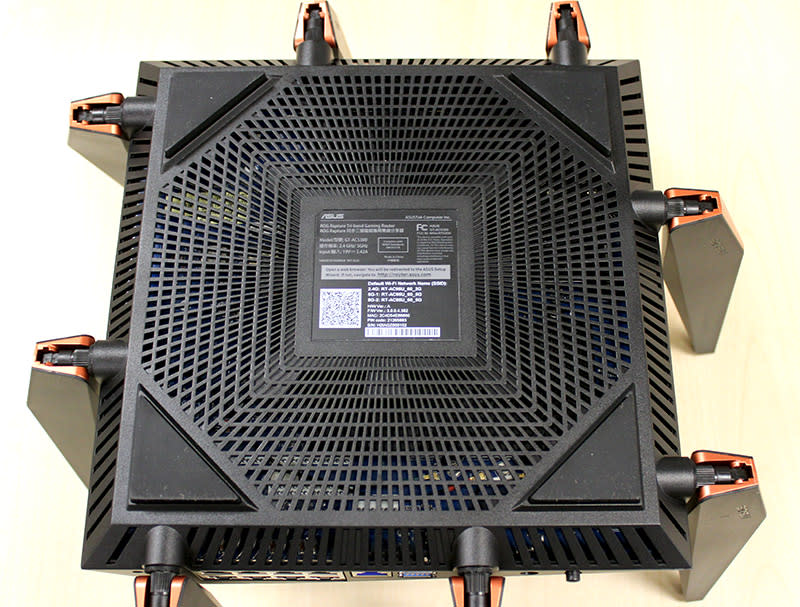
Inside, the ROG Rapture GT-AC5300 has upgraded internals. The CPU has been upgraded and its one of the fastest I have seen in a router. Specifically, the ROG router is running a 64-bit Broadcom BCM49408 processor that is clocked at 1.8GHz. It also has a massive 1GB of RAM, which is also the most that I have seen on any router. Clearly, the ROG Rapture GT-AC5300 is one powerful router.
Alongside the powerful processor, the ROG Rapture GT-AC5300 uses three BCM4366 radios for transmission. This is the same of radios that most AC5300-class routers use. These radios support 4x4 streams and also support MU-MIMO. Rated speeds are as follows: 1,000Gbps on the 2.4GHz network and 2,167Mbps each on its two 5GHz networks. Add them all up and you get 5,334Mbps.
The reason the ROG Rapture GT-AC5300 requires such a powerful processor is because of the wealth of features that it packs. Let’s begin with the more obvious ones first - the ports. In keeping with today’s increasing connected households, the ROG Rapture GT-AC5300 comes with a single Gigabit Ethernet WAN port and 8 Gigabit Ethernet ports.

But that’s not all, out of the 8 Gigabit Ethernet LAN ports, two are dedicated gaming LAN ports that are optimized and have top priority over all other traffic. Apart from the gaming ports, there are another two LAN ports that support link aggregation, allowing users to combine them to create a single super-fast 2Gbps connection. This is useful especially if you have a high-end NAS system connected to the router.
Speaking of connections, the ROG Rapture GT-AC5300 also comes with two USB 3.0 ports. It’s worth noting that most routers, even high-end ones, usually only come with a single USB 3.0 port, the other USB port usually only supports slower USB 2.0 speeds. Faster USB 3.0 ports are preferred especially if you wish to share files over your network using external storage drives.
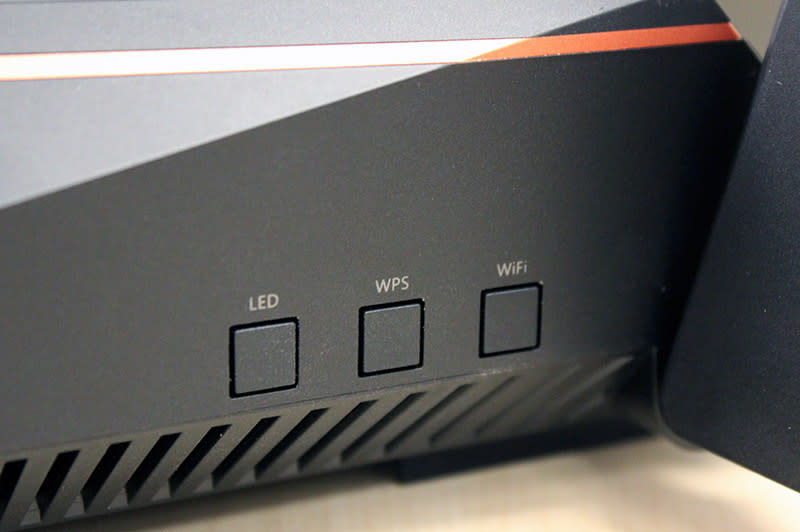
Ports aside, the ROG Rapture GT-AC5300 also has LED status indicators on its front and also buttons to quickly turn off Wi-Fi and the LED status indicators. There's also an additional button for quick WPS setup needs.
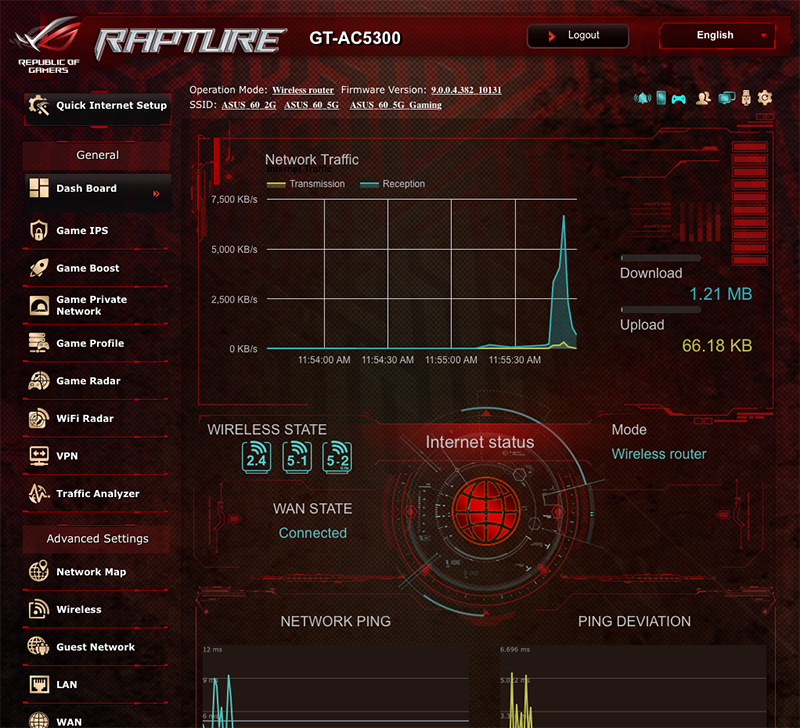
Beyond the high-speed Wi-Fi networks and extensive LAN and USB connections, the ROG Rapture GT-AC5300 also comes with a new router management interface called ROG Gaming Center. It is, as you can see from the screen-capture above, very red and quite cool. Long-time ASUS users will probably recognize it as being very similar to the ASUSWRT router management interface that is found on their regular non-ROG routers, but look closer and there are some notable differences.

Under the General tab, you can see a couple of Gamer-centric features like Game IPS, Game Private Network and Game Profile. Curiously, some of them are actually a rename of features found on other ASUS routers. For example, Game IPS is really the same AiProtection, and you can find Game Boost and Game Private Network on other ASUS routers too.
What is new and useful to gamers, however, are Game Profile and Game Radar. Game Profile automatically sets up Port Forwarding for popular online games like CS:GO, World of Tanks, World of Warcraft, Starcraft II, and Overwatch. Just select the game from a drop-down menu, hit Apply, and you are done.
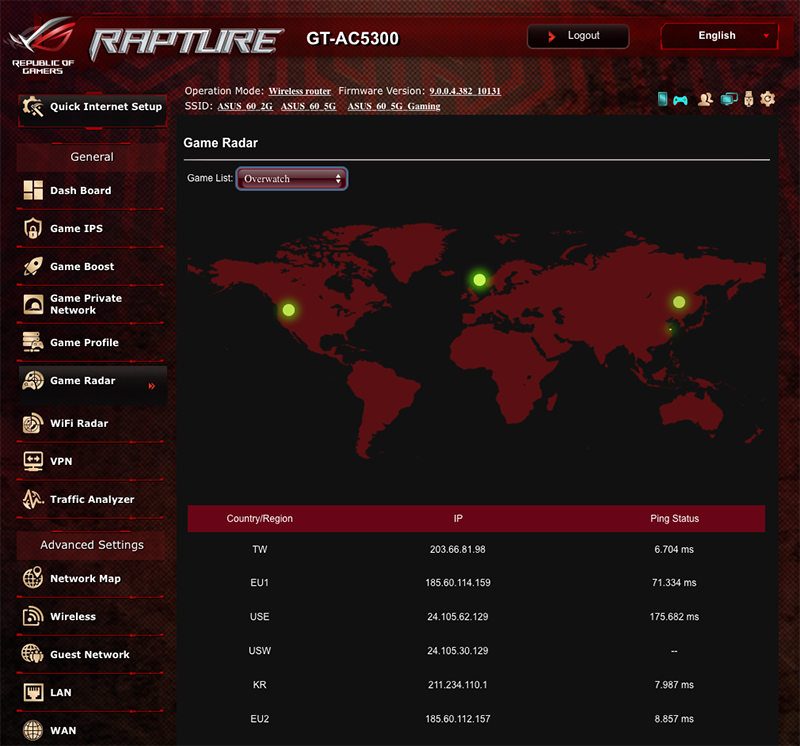
Game Radar, on the other hand, shows you the ping status of game servers of popular online games like Dota 2, Overwatch, World of Warcraft and more. So if the game you play allows you to pick a server to connect to, you know which one has the lowest latency.
Another new feature that is found on the ROG Rapture GT-AC5300 is WiFi Radar, which is a wireless network scanner tool.
Elsewhere, the ROG Gaming Center has the same features and functions found on other ASUS routers such as Game Boost, Traffic Analyzer, Guest Network, Network Map, AiCloud, Parental Controls, Adaptive QoS and more. In a nutshell, what you are getting with the new ROG Rapture GT-AC5300 router is all the features found on other high-end ASUS routers, plus new ones like Game Profile and Game Radar that will delight gamers.
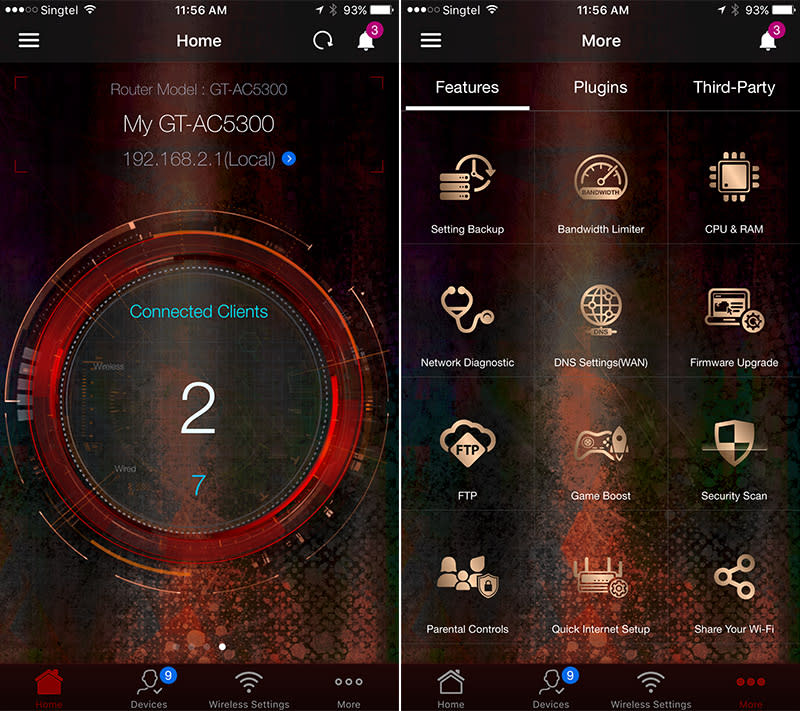
Of course, like any respectable high-end router these days, the ROG Rapture GT-AC5300 router can be remotely managed and controlled using the ASUS’ suite of mobile apps that can be installed on your iOS or Android mobile device. There are four apps in total. The ASUS Router app lets you monitor router usage and alter QoS settings. The AiCloud app is required if you want to enable cloud storage functionality. The Download Master app lets you schedule files for download using torrent clients. And lastly, Device Discovery traces all your ASUS networking devices, including your router, repeater and IP camera. The apps are easy enough to use, but it’s a cumbersome system and we would rather have had a single app that can do it all.
Test setup
Our routine test setup includes a desktop PC, the reviewed router, and a laptop to simulate a wireless home network. The desktop system takes on the role of a host machine, while the router acts as a gateway. And lastly, an external Wireless 802.11ac adapter attached to the notebook is used to fulfill the role of a wireless remote client. The router is locked down in N-only mode for the 2.4GHz band, and 802.11ac for the 5GHz band, mainly to prevent the use of varying 802.11 standards. Typically, a channel bandwidth of 40MHz is selected where applicable, while 80MHz is used for the 5GHz AC band.
We'll be using Netgear's A6200 802.11ac USB adapter for our throughput tests to reduce the number of variables involved. The Netgear A6200 USB adapter supports up to two spatial streams for a maximum data transfer rate of 867Mbps - the maximum for USB adapters currently. Hence, if your system has a more advanced wireless chipset that supports three spatial streams, you can expect even higher speeds.

To evaluate, we will be using a mix of synthetic benchmarks and real-world testing. The synthetic benchmark we are using is called LAN Speed Test. As for real-world testing, we will be measuring the routers’ speeds in transferring a 1GB zip file. We will do multiple tests at different distances to simulate use around a typical home. For the 5GHz band, we also measured how performance is affected if two clients are connected and uploading and downloading data at the same time. Here are the test distances we used and what they represent.
2m - Right beside the router.
5m - In the adjacent room.
13m - In the room opposite.
17m - To simulate extreme distances
An important thing to note is that we will be phasing out 2.4GHz testing from our benchmarks. For one, 802.11ac is now being widely supported by most if not all mobile devices. If your device supports 802.11ac, it makes absolutely no sense to connect to the router via the slower and more congested 2.4GHz band. Speaking of congestion, our test environment currently has no less than 19 different 2.4GHz networks being broadcasted. The amount of noise and interference makes it very difficult for us to properly evaluate 2.4GHz performance. As such, we'll only be presenting performance from the 5GHz band.
Performance Analysis
We pitted the new ROG Rapture GT-AC5300 against its predecessor - the RT-AC5300 - and also a trio of AC-5300 class routers from D-Link, Linksys, and TP-Link. Looking at its performance in the uplink and downlink tests, it is hard to not be impressed. The ROG Rapture GT-AC5300’s uplink speeds were easily amongst the quickest at all tested ranges. As for downlink speeds, the ROG Rapture GT-AC5300 was even more impressive, as it turned in the highest speeds across all ranges.


The ROG Rapture GT-AC5300’s performance in the file transfer tests were equally formidable. Its speeds were a good deal faster than the older RT-AC5300 and it was easily one of the fastest routers that we have tested. Its performance at the farther ranges of 13 and 17 meters were particularly impressive.

Finally, the ROG Rapture GT-AC5300 performed admirably in our performance load test where we downloaded data simultaneously using two notebooks from our host computer. We can see that it suffered very little performance penalty even with two devices connected and streaming data from the router at the same time. Unfortunately, the ROG Rapture GT-AC5300 wasn't the quickest here and lost out, albeit by only a small margin, to the D-Link DIR-895L and Linksys EA9500.

A dream router for gamers
2016 was a quiet year for ASUS’ routers, but they are back with a bang. The ROG Rapture GT-AC5300 lives up to its fearsome name by delivering outstanding results in our tests. Uplink and downlink performance was very strong in general, and its performance at farther ranges was impressive. All in all, the ROG Rapture GT-AC5300 lives up to its billing as ASUS’ new flagship router, and it is also one of the fastest routers we have ever tested.
Performance aside, the ROG Rapture GT-AC5300 also comes with loads of features and some are really quite handy. Game Profile, for example, makes it very easy to users to setup port forwarding settings for games. WiFi Radar, on the other hand, lets you monitor your Wi-Fi environment and pick the cleanest channels for your own Wi-Fi network.

And then there’s a rich amount of connections that the ROG Rapture GT-AC5300 has. 8 Gigabit Ethernet ports should be the standard for flagship routers, but not only does the ROG Rapture GT-AC5300 have 8 Gigabit Ethernet ports, it even has two dedicated ports that are optimized and have top priority over all others for gaming. And beyond that, it also has two ports that support link aggregation, allowing users to create a single super-fast 2Gbps connection that will be especially useful for hooking up to a high performance NAS system. Oh, it has two USB 3.0 ports too - handy for connecting to external storage devices.
In closing, gamers will find a lot to like about the ROG Rapture GT-AC5300. The only thing that might put them off is the price. At $559, the ROG Rapture GT-AC5300 is one of the priciest routers in the market today, but we feel that it justifies its price tag with its incredible performance and rich set of features.
Readers will probably be most interested to know how it compares against the Linksys EA9500, the winner of this year's Tech Awards for Best Wireless Router. Both are great routers, but the ROG Rapture GT-AC5300 is a tad quicker and offers more in terms of features. The Linksys EA9500, however, is no slouch and it has a much more refined user interface. For advanced users, our recommendation would be the ROG Rapture GT-AC5300, especially if you also have a high-end NAS system. For others who just want a fast tri-band wireless router, the Linksys EA9500 is perfect, but don't forget that there are more affordable options from the likes of D-Link and TP-Link too.


